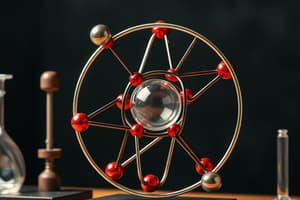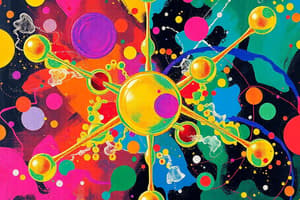Podcast
Questions and Answers
What is the electronic configuration of Cu+ ion?
What is the electronic configuration of Cu+ ion?
- 3d10 4s1
- 3d10 4s0 (correct)
- 3d9 4s2
- 3d4 4s2
Which of the following atoms has the largest atomic radius?
Which of the following atoms has the largest atomic radius?
- Na (correct)
- Li
- Be
- B
What type of overlap results in a π-bond?
What type of overlap results in a π-bond?
- overlap of two p-orbitals (correct)
- overlap of two s-orbitals
- overlap of an s- and a d-orbital
- overlap of an s- and a p-orbital (correct)
What is the ground electronic state of Mn2+?
What is the ground electronic state of Mn2+?
What is the result of the capability of alcohols to form intermolecular hydrogen bonds?
What is the result of the capability of alcohols to form intermolecular hydrogen bonds?
Which of the following halogen ions has the highest reductive properties?
Which of the following halogen ions has the highest reductive properties?
How many neutrons does an atom of element X have?
How many neutrons does an atom of element X have?
The electronic configuration of Cu* ion is:
The electronic configuration of Cu* ion is:
Which is the correct order for the listed atoms with an increase of the atomic radius?
Which is the correct order for the listed atoms with an increase of the atomic radius?
An n-bond is the result of:
An n-bond is the result of:
What is the ground electronic state of Mn*:
What is the ground electronic state of Mn*:
The capability of alcohols to form intermolecular hydrogen bonds leads to:
The capability of alcohols to form intermolecular hydrogen bonds leads to:
Which is the correct order of halogen ions with decrease of reductive properties?
Which is the correct order of halogen ions with decrease of reductive properties?
The element X has an atomic number of 8 and mass number of 17. The atoms of this element contain:
The element X has an atomic number of 8 and mass number of 17. The atoms of this element contain:
Flashcards are hidden until you start studying
Study Notes
Electronic Configuration and Atomic Structure
- The electronic configuration of Cu⁺ ion: 3d¹⁰ 4s¹
- Atomic radius generally increases down a group in the periodic table; the correct order for Li, Na, B, Be is B, Be, Li, Na.
- The ground electronic state of Mn ion includes electron configurations: 1s² 2s² 2p⁶ 3s² 3p⁶ 3d⁵.
Bonding and Molecular Interactions
- An n-bond results from the overlap of two p-orbitals.
- Alcohols form intermolecular hydrogen bonds, leading to increased boiling points and vapor pressure while enhancing solubility in polar solvents.
Reductive Properties of Halogens
- The correct order of halogen ions with decreasing reductive properties is I⁻, Br⁻, Cl⁻, F⁻.
Isotopic Composition
- Element X with atomic number 8 (Oxygen) and mass number 17 contains 8 protons and 9 neutrons.
- Since the atomic number equals the number of protons, element X has 8 electrons in a neutral state.
Electronic Configuration and Atomic Structure
- The electronic configuration of Cu⁺ ion: 3d¹⁰ 4s¹
- Atomic radius generally increases down a group in the periodic table; the correct order for Li, Na, B, Be is B, Be, Li, Na.
- The ground electronic state of Mn ion includes electron configurations: 1s² 2s² 2p⁶ 3s² 3p⁶ 3d⁵.
Bonding and Molecular Interactions
- An n-bond results from the overlap of two p-orbitals.
- Alcohols form intermolecular hydrogen bonds, leading to increased boiling points and vapor pressure while enhancing solubility in polar solvents.
Reductive Properties of Halogens
- The correct order of halogen ions with decreasing reductive properties is I⁻, Br⁻, Cl⁻, F⁻.
Isotopic Composition
- Element X with atomic number 8 (Oxygen) and mass number 17 contains 8 protons and 9 neutrons.
- Since the atomic number equals the number of protons, element X has 8 electrons in a neutral state.
Studying That Suits You
Use AI to generate personalized quizzes and flashcards to suit your learning preferences.




